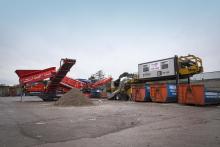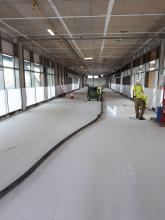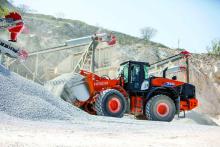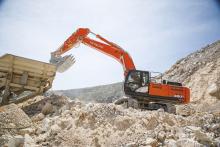
Recycled aggregates are in growing demand among residential and commercial building firms and highways contractors worldwide, partly due to the value for money they offer compared to virgin aggregates. The quality of secondary aggregates is also at an all-time high. Guy Woodford reports.
Given its increasingly attractive production quality to cost ratio, coupled with many national and regional governments’ tougher environmental regulations aimed at restricting the use of virgin materials, it is no wonder that recycled aggregates are being used more and more in highways and other key infrastructure works.
Europe is among the continents with a growing secondary aggregates sector, with not only recycling-suited crushers and screeners, but also recycling market-orientated loaders and loader attachments in demand.
For example, TIB Recycla SA (TIB) has selected a new
The plant – located within the municipality of Mezzovico-Vira – was completed in August 2017. The ZW310-6 is being utilised on site to drive up the steep ramp and feed the machine with freshly delivered materials. Its other main task is to load delivery trucks with finished aggregates for onward transportation by road or rail.
TIB was established in 2014 as a partnership between three companies: Toggenburger, Implenia and Bizzozero. The purpose of TIB’s new facilities is to provide the construction industry with the opportunity to dispose of excavated and demolished materials, and acquire the recycled aggregates for reuse in building and other projects across Switzerland.
The medium wheeled loader was delivered in the third quarter of 2017, along with three Hitachi medium excavators – a ZX240-5, ZX135US-6 and ZX300-6. TIB says it was happy to invest in the new machinery, owing to the reliability of the equipment and the relationship it shares with Probst Maveg. “Hitachi is strong in this region and the most important element for us is the exemplary service,” said TIB’s director Roberto Bizzozero.
“We benefit directly from our dealer’s top-quality approach, and enjoy a friendly business relationship and high level of professionalism with our main point of contact. The ZW310-6 is working for around 15 hours per day, so it has to be reliable. Apart from preferring the orange Hitachi colour, we highly appreciate the quality associated with the brand and the high resale value.”
Despite working with another manufacturer over the past 30 years, Bizzozero has enjoyed 15 years of Hitachi ownership even more: “We opted for the ZW wheeled loader due to the total cost of ownership, driven by its low fuel consumption, as well as the high price/quality ratio.”
Operator Damiano Alberton has also been impressed with TIB’s new acquisition: “The driving position in the ZW310-6 is perfect – the best one I have experienced – and the noise levels in the cab are low. In addition, the visibility is ideal for both feeding the recycling installation and loading trucks with the finished materials. The power and torque of the engine are also excellent for travelling up the steep ramp.”
Remaining in Europe,
Filmed in conjunction with The Sheehan Group, a family-run business, specialising in construction and civil engineering, viewers can watch the full process from the removal of waste materials from a construction site, recycling the waste materials by wet processing to their reuse in a residential construction project.
The Sheehan Group, based in Oxford, England, recognised the need to optimise the reuse of waste materials and the business opportunities in this area. In 2012 they invested in an advanced construction and demolition waste recycling system from CDE. The facility uses the latest wet processing methods to create a range of certified sand and aggregates which are being used in concrete products for the construction industry. The company is also able to use the filter cake material to engineer landfill cells and cap landfill sites.
Tara Sheehan, financial director, The Sheehan Group, said: “We received regular requests for alternative sustainable products. This facility enabled us to fulfil these requests.”
The bespoke recycling plant contains a range of equipment which comes together to create an innovative wet processing solution. The plant includes a feed system, AggMax portable logwasher, Infinity screens and Evowash sand washing plant. In addition, the system employs full closed-circuit water recycling with the inclusion of the Aquacycle thickener and filter press.
Eunan Kelly, CDE Reco business development manager for Europe, said: “CDE Reco is continuously exploring innovative ways to increase diversion from landfill by exploring higher value opportunities for recovered CD&EW materials. We work in close collaboration with each customer to develop a tailored solution to maximise the volume of material that they can return into the construction market.”
Last year The Sheehan Group celebrated reaching the milestone of diverting over 500,000tonnes of waste from UK landfill sites using the CDE recycling plant.
Chris Sheehan, the company’s managing director, said: “The CDE installation has allowed us to take better control of our business and integrate our recycled products into construction projects. For example, we now make concrete blocks and ready-mixed concrete using recycled sand and aggregates which were formerly waste materials.”
A county Cheshire, North West England-based waste management company is one of the first to take delivery of Kiverco’s mobile recycling plant from Finlay Central.
Part of the
Said to offer the benefits of a high performance stationary plant, the new mobile Kiverco PS122 picking station combines manual sorting, magnetic and air separation in a compact unit.
The new Terex Finlay 883+ is feeding the picking station with material brought in from the company’s skips.
It is processing the material into three different sizes, -25mm, 25mm to 100mm, which is then processed by a density separator, giving a clean fraction of stone, and an oversize that is fed to the picking station.
Replacing an old static picking station, the Kiverco PS122 at Henshaws has been fitted with an overband magnetic module to recover ferrous metals, as well as a variable speed, heavy-duty fan blower to remove light fractions from the material.
The four-man picking line removes wood, plastic and cardboard, which then go for recycling, while the heavy material is crushed and sold on to customers.
“The Kiverco PS122 came to site and was set up in no time at all. It’s incredibly easy to use and we’re really impressed with it,” says James Henshaw, transport manager at Henshaws.
“And as always, the Terex Finlay 883+ doesn’t disappoint, we’ve had them in the past and they’re just a great machine. Together the two machines provide us with an optimum solution.”
The high-performance Terex Finlay 883+ is designed to work after a primary crusher or on its own as a frontline tracked mobile screening machine.
It has the capacity to process material at a rate of up to 500tonnes/hour and is said to be an ideal plant for applications such as quarrying, recycling and demolition debris, as well as sand, gravel, coal and aggregates.
The Kiverco PS122, along with the Terex Finlay 883+, will be joining the company’s extensive hire fleet, all specified by Finlay Central.
“Now everything has settled in, it’s all systems go and we want to get both plant hired out,” added James Henshaw.
With extensive industry knowledge and employing over 70 staff, Henshaws has grown to become a leading waste recycling operator in the North West.
As well as plant hire, the family-run company also offers skip hire, aggregates, scrap car and metal recycling as well as tipping facilities.
“The new Kiverco PS122 is a great piece of kit, it’s easy to move and simple to set up,” says Neil Partington of Finlay Central.
“The insulated sorting cabin is fitted with PVC doors and windows and is far more comfortable for the operators. Air conditioning is also an optional extra.”
Last year, Finlay Hire, part of the Finlay Group of companies, became a licensed hire specialist for Kiverco in England and Wales, specifically for the new and recently introduced mobile Kiverco compact plant range.
Designed for the small to medium-size waste processing operator or mobile contractor, the new range includes a feeder trommel, a picking station and density separator, while modular components can be selected to provide a bespoke solution for waste processors.
The new Kiverco compact range can be quickly and easily set up on site, without cranes, and ready to work within a few hours.
Aggregate Industries’ ground-breaking secondary aggregate,
Labelled as Birmingham, Central England’s newest ‘super hospital’, the £370 million (€420mn) facility has been designed to meet the best international and national standards, bringing patient requirements firmly to the forefront to support the efficient delivery of high-quality clinical services. Due to open in 2019, the hospital will provide 669 acute care beds and 13 operating theatre suites at its new home on Grove Lane, Smethwick.
Integral to the project is an overriding onus on sustainability with the building ear-marked to be in the top 10% of non-domestic buildings in terms of sustainable performance, achieving a Building Research Establishment (BRE) Environmental Assessment Method (BREEAM) rating of very good or higher on completion. This is seen through all aspects of the supply chain and associated infrastructure; from the integration of energy-efficient technologies and systems through to the use of sustainable material choices.
In preparing to start works, the specification of the fifth-floor transfer slab within the building design presented a challenge for the architect, HKS, whereby the allocated 400mm Lytascreed build-up was subsequently amended due to loading criteria provided by the structural engineer with a max load of 2.5kN/m2. In turn, the design team wanted to eliminate the use of void formers throughout the project, but due to the scale of build-up required a middle ground had to be met.
To overcome the challenge,
Steve Curley, general manager at Lytag, said: “This is another great example of how the lightweight properties of Lytag have provided a solution on a large-scale project.”
In production for more than 50 years, Lytag secondary aggregate is made using innovative technology which transforms fly ash into small pellets which are then heated to 1,100°C. The pellets formed are rounded in shape and range in size from 14mm down to fines and can be used as a superior, consistent, lightweight aggregate.
In total, Aggregate Industries will supply 450tonnes of Lytag for the Midlands Metropolitan Hospital.
KINSHOFER’S RECYCLING-SAVVY MULTI-QUICK PROCESSORS
“We know that by enabling contractors to complete more jobs with fewer pieces of equipment, we boost their profitability and expand their businesses,” said Francois Martin, KINSHOFER North America general manager. “The KINSHOFER Multi-Quick Processor is the ultimate tool to do just that. Like all our products, the processor offers features to help customers do more with less.”
KINSHOFER’s MQP features the company’s DemaPower cylinder technology. The cylinder uses four chambers instead of the two found in other attachments, resulting in a claimed 20% more surface area within the cylinder. That is said to allow the MQP to exert up to 25% more power from a smaller attachment, resulting in the best power-to-weight ratio in its size class. KINSHOFER says this means, for example, that a section of concrete that may take another attachment five or six “bites” to break through, only takes the MQP one or two. Higher power in a smaller tool is also said to improve efficiency and performance in high-reach demolition, a practice that’s becoming more common in the U.S. This is both because contractors can use a smaller carrier with a higher-powered attachment and because the attachment’s light weight and superior cylinder technology improve fuel efficiency while the excavator arm is fully extended.








